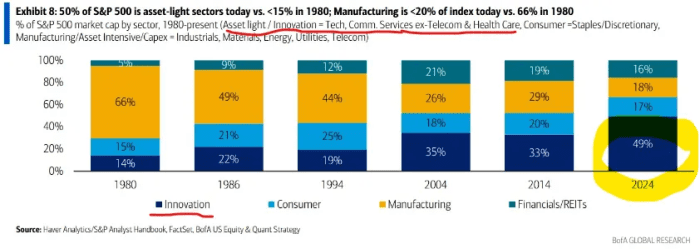One of many enduring puzzles of the present financial power is how little influence the Fed’s fee hikes appeared to have triggered — not producing the recession or disaster that each earlier mountain climbing cycle over the past 70 years has executed.
The hikes, from zero all the way in which as much as the present vary of 5.25% and 5.5% in only a yr and a half, did influence elements of the financial system: new-home gross sales, as an example, slumped from an annual fee of 830,000 simply earlier than the speed hikes to as little as 543,000, and are nonetheless solely at 661,000. Manufacturing manufacturing has mainly flat-lined, and solely now are there indicators of it enhancing.
However the U.S. financial system simply isn’t that interest-rate delicate anymore. Moses Sternstein of the Random Stroll weblog shared this chart, initially produced by Financial institution of America, displaying the share of the S&P 500
SPX
made up of what it calls asset-light sectors, which embrace expertise in addition to health-sector corporations.

And whereas that’s simply the inventory market, the broader financial system can also be much less capital intensive.
He mentioned the true influence of upper rates of interest on tech corporations is that it made them extra environment friendly. Sternstein famous that tech corporations as charges began rising targeted extra on money stream over gross sales progress. “Buyers could not adore it as a result of whereas revenue is okay, progress is the horny half, however from the standpoint of ‘wheels staying on the financial system,’ then revenue works simply positive,” he writes.
As for the market, Sternstein shared a chart of the unfold between B and BB rated junk bonds getting tighter. “Both a wicked-dead cat bounce with a number of egg on everybody’s faces, or doggone it, we’re off to the races once more,” he mentioned.
The S&P 500 ended February at a file excessive after a 5.2% surge, and the index has climbed 21.5% over the past 4 months alone.
